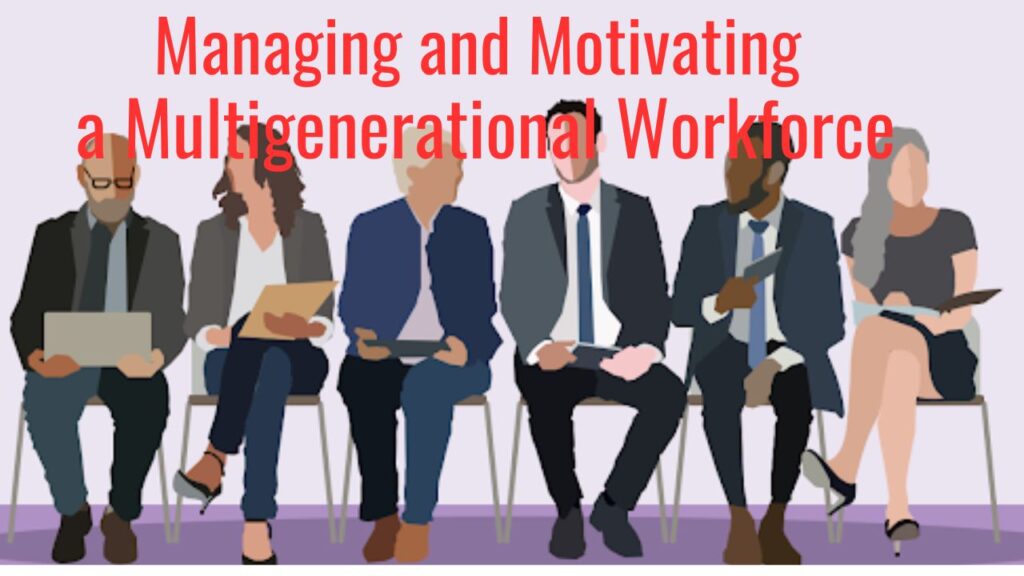The workplace is ever-changing and evolving, with the most recent challenge being managing a multigenerational workforce. A multigenerational workforce means two or more different generations of people coming together to do their jobs in a workplace. Some examples of generational groupings include; traditionalists (born before 1945), baby boomers (born 1945-1965), Generation X (born 1965-1980), and millennials (born 1980-2000).
This article will discuss the importance of managing and motivating a multigenerational workforce. It will consider the strategies employers can use to effectively engage and integrate each generation into the workplace, be it a physical office, remote workplace, or hybrid of the two. The article will identify common workplace conflicts that can arise from managing multiple generations and provide measures employers can take to resolve issues. The article will also include best practices for employers to create an environment where each generation can work together and strive towards common goals.
Advertisement
Background
Advertisement
The workplace is no longer made up of a single generation, rather employers are now faced with the challenge of employees coming from a variety of backgrounds, with different generational values and expectations in the workplace. According to a 2018 report by the U.S. Bureau of Labor Statistics, millennials, who accounted for 22% of the American workforce, were the largest working generation in the U.S. That same report also stated that 18% of the American workforce were Baby Boomers and 14% were Generation Xers.
Multigenerational workforces can present employers with the challenge of creating a work environment where each generation works collaboratively, shares knowledge, and works together to achieve common goals. Each generation has its preferences when it comes to communication and management styles and employers must be able to adjust their management approaches to meet the needs of each generation.
Advertisement
Advantages of a Multigenerational Workforce
The multigenerational workforce presents many advantages to employers, including:
1. A Wide Range of Skills, Knowledge, and Experience
Having members of different generations in the workplace means employers can benefit from a wide variety of skills and knowledge. Baby Boomers may have experience in more traditional roles and employment practices meaning employers can tap into a wealth of knowledge about how things have been done in the past. Millennials, on the other hand, can provide insight into more modern approaches to work and new technologies, both of which can be beneficial when it comes to moving an organization ward.
2. Different Positive Perspectives
Having a wide range of different perspectives from different generations can help employers to make more informed decisions. Different generations often have different preferences, opinions, and experiences when it comes to tasks and processes, which can be invaluable for solving workplace issues.
3. Diversity
Having a multigenerational workplace can add diversity to an organization, which can be beneficial in terms of recruitment and creating a work environment that is open and welcoming to all.
Managing a Multigenerational Workforce
Effectively managing a multigenerational workforce requires employers to take a different approach to how they manage each generation. Employers must be aware of the different preferences, motivations, and expectations of each generation and work to create an environment where each generation can work together, share knowledge, and strive towards common goals.
The following are strategies employers can use to manage a multigenerational workforce effectively:
1. Flexible Scheduling
Different generations have different preferences when it comes to work/life balance and schedule flexibility. Employers must be willing to offer flexibility, allowing for part-time, flexible hours, and remote working to accommodate the differing needs of each generational group.
2. Clear Communication
Effective communication is essential for any team but is especially important for a multigenerational team where members may have different preferences when it comes to communication styles. Employers should establish clear communication guidelines, outlining the preferred communication method for each generation and the frequency and method of communication.
3. Introduce Mentoring and Training
Providing opportunities for mentoring and training is a great way to recognize the skills and knowledge of each generation and bridge the generational gap in the workplace. Mentoring and training sessions can help to create a culture of collaboration, where members of each generation can learn from each other and share their expertise.
4. Establish Relevant Rewards and Incentives
Different generations may have different motivations and employers should offer rewards and incentives that are relevant to each generation. Where possible, employers should tailor rewards and incentives to the preferences of each generational group.
5. Implement Multi-Generational Teams
Incorporating multi-generational teams into the workplace is a great way to foster a sense of collaboration and inclusivity. Assigning tasks and projects to teams that represent the diversity of the workplace creates an environment where members of each generation can learn from each other, share their knowledge and create innovative solutions.
Conflicts That Can Arise From Managing a Multigenerational Workforce
Despite the potential advantages of managing a multigenerational workforce, there can also be issues and conflicts if employers fail to effectively manage and motivate the different generations.
1. Stereotypes and Preconceptions
Stereotypes and preconceived ideas about different generations can lead to issues in the workplace. Subjective opinions about a particular generation can result in unequal treatment and lead to feelings of alienation for members of that generation.
2. Generational Divides
Generations can often be divided in terms of expectations, work ethic, and preferences. While this can be beneficial in terms of gaining a wider range of perspectives, it can also lead to feelings of resentment and animosity between colleagues of different generations.
3. Inadequate Communication
Inadequate communication and misunderstandings can arise due to generational differences in communication preferences. Different generations prefer different communication methods and those differences can lead to issues if not managed properly.
Resolving Conflicts and Best Practices
Despite the potential conflicts that can arise from managing a multigenerational workforce, there are measures employers can take to resolve any issues, and create an environment where different generations can work together successfully.
1. Promote Respect and Professionalism
Creating a culture of respect and professionalism is essential for any workplace, but is particularly important when dealing with a multigenerational workforce. Encouraging employees to treat each other with respect and to take time to learn about each other’s backgrounds, experiences and values are key.
2. Provide Cross-Generational Training
Providing training on generational differences and how to work with colleagues of different generations can help to reduce misunderstandings and foster collaboration. This type of training should include topics such as generational expectations, preferences, and communications styles as well as strategies for working collaboratively.
3. Encourage Open Dialogue
Encouraging open dialogue is key to resolving any potential conflicts. Establishing an environment where each generation feels comfortable expressing their thoughts and opinions can help to reduce misunderstandings and foster collaboration.
Conclusion
The workplace is changing, with employers now having to manage and motivate a multigenerational workforce. While this presents new challenges, it also presents many advantages. Employers can benefit from the diverse range of skills and knowledge, as well as the different perspectives each generation has to offer. To successfully manage and motivate each generation, employers should take a tailored approach to management and create an environment of respect and professionalism, which encourages open dialogue and collaboration between colleagues of different generations.

